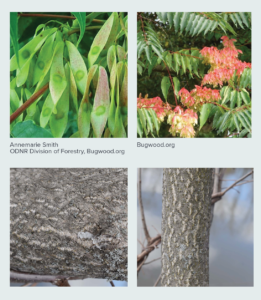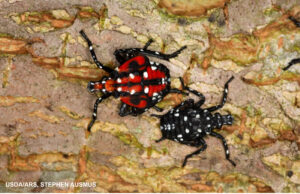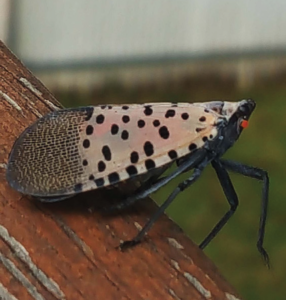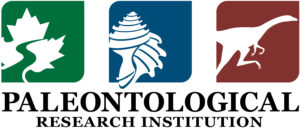Have you seen this colorful insect? The Spotted Lanternfly (SLF), also known as the blistering cicada, is a sap-feeding insect native to Asia. They have been found in the United States and were first discovered in Berks County in southeastern Pennsylvania in 2014. Since then, they have spread to other Northeastern states including Connecticut, Delaware, Maryland, New Jersey, New York, and Virginia.
This insect can cause a great deal of harm to New York’s forests, agricultural and tourism industries. The preferred host of these insects is the Tree of Heaven, though they will also feed on 70 different species of trees. Vines, shrubs and trees including grapevine, hops, apple trees, stone-fruit trees and hardwoods, such maple and walnut, will be affected. The Spotted Lanternfly can easily spread to other new locations as people travel from states that have the SLF infestation, being transported on vehicles and equipment.
The Tree of Heaven bark has the appearance of a gray cantaloupe and the twigs have an alternate-leaf arrangement with leaflets from one-foot to four-feet long. Seeds on the female trees are winged samaras that change color from green to pink and then yellow to brown. This tree wipes out native species with its dense thicket and toxins that it excretes into the soil.
from one-foot to four-feet long. Seeds on the female trees are winged samaras that change color from green to pink and then yellow to brown. This tree wipes out native species with its dense thicket and toxins that it excretes into the soil.
The SLF’s specialized mouth parts suck up the sap by piercing the leaves, stems and trunks of vines and trees causing oozing sap, wilting leaves and branch dieback. The Spotted Lanternfly also excretes large amounts of sticky honeydew that can attract other insects and sooty mold that interferes with plant photosynthesis, negatively affecting the growth and fruit yield of plants.
Spotted Lanternflies cannot harm humans directly, as they neither bite nor sting, but their presence outdoors and indoors, can be unpleasant.
The following is the life cycle of the Spotted Lanternfly that completes a one-year generation from eggs to nymphs to adults.
September to May—Egg Masses
- Egg masses can be found on tree bark, rusty metal, rocks, outdoor furniture, vehicles, vehicle grills, and other smooth
 surfaces.
surfaces. - The insect tends to lay their eggs in areas protected from harsh winds like the underside of a tree limb or on any surface that is sheltered.
- Size of an egg mass ranges about 1″ long and a 1/2″ to 3/4″ wide.
- Their color varies from off-white, tan, gray or brown.
- Laid eggs resemble a small patch of mud that appear to have a waxy shiny coating that becomes dry and cracked over time. Old egg masses can shed their covering and look like four to seven rows of seed-like eggs, 30 to 50 eggs.
April to October—Nymphs
- Eggs hatch in the spring and small black nymphs with white spots begin feeding.

- They complete four stages, called instars, before becoming adults, they have no wings.
- The first three stages, the nymphs are black with white markings.
- The fourth instar stage, nymphs are reddish-orange with white spots and black patches.
- They can grow over a 1/2″ long and hop suddenly when approached or touched.
July to November—Adults
- The adult commonly appears in late summer and fall.
- The insects at rest are grey, with faint pink wings that have many round black spots with a black-brick like pattern on the tips. The wing tips are black and gray with a webbed presence.

- When flying or startled, the SLF will show bright red hind wings with black spots, have a black head, and a yellow abdomen with black bands.
- Adults are 1.5” to 2.5” wide when wings are spread. They are 1” long and 1/2″ wide when wings are folded.
- They also hop when startled.
- After mating, adult females lay eggs beginning in September and continue through November or early December. The eggs overwinter until the following spring.
So, “What can you do”? if you spot this invasive species
- Learn how to recognize the Spotted Lanternfly by appearance during all it stages.
- Check out trees, firewood, vehicles and outdoor furniture for egg masses.
- If you visit these states, Pennsylvania, New Jersey, Maryland, Delaware, West Virginia, and Virginia, that are known to have SLF infestations, please check for egg masses on your car, equipment and gear before leaving the state.
- If you believe you have sited SLF in New York
- Take pictures of the egg masses, nymph stage insects or adults by placing a coin next to it for scale.
- Note location including address, landmarks, roads or GPS coordinates.
- Report the infestation with photographs and location to IMapInvasives at nyimapinvasives.org/slf or reach out to spottedlanternfly@agriculture.ny.gov
- Egg masses can be scraped off with a stick or plastic card and then destroyed by filling a container with alcohol, hand sanitizer or very soapy water to kill the eggs. Eggs can also be burned in a campfire.
Links
The following link is to an article about an infestation in Ithaca and tree removal to stop the spread.
https://ithacavoice.com/2021/04/spotted-lantern-fly-infection-causes-stewart-ave-tree-removal/
This is New York State Department Agriculture and Market’s SLF page. It has a lot of links for more information. https://agriculture.ny.gov/spottedlanternfly
Here is our SLF public reporting form. This can be used to submit location information, contact information, and photos to us.
https://survey123.arcgis.com/share/a08d60f6522043f5bd04229e00acdd63
https://www.nyimapinvasives.org/slf
http://fingerlakesinvasives.org/spotted_lanternfly/
Penn State also has a good article on the management of SLF in vineyards. https://extension.psu.edu/spotted-lanternfly-management-in-vineyards
https://www.ithacaweek-ic.com/through-the-grapevine-wineries-and-the-spotted-lanternfly/
Top-Tier Supporters of the Cayuga Lake Scenic Byway, Inc. Enjoy the Ride!















